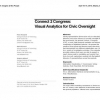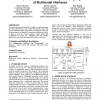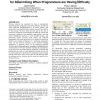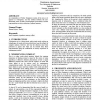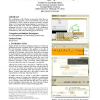CHI
2010
ACM
13 years 12 months ago
2010
ACM
Strong representative democracies rely on educated, informed, and active citizenry to provide oversight of the government. We present Connect 2 Congress (C2C), a novel, high tempo...
ICMI
2009
Springer
14 years 27 days ago
2009
Springer
This article introduces HephaisTK, a toolkit for rapid prototyping of multimodal interfaces. After briefly discussing the state of the art, the architecture traits of the toolkit ...
GROUP
2010
ACM
14 years 1 months ago
2010
ACM
Previous research has motivated the idea of automatically determining when programmers are having difficulty, provided an initial algorithm (unimplemented in an actual system), an...
ICFP
2010
ACM
14 years 4 months ago
2010
ACM
We present a case-study of using OCaml within a large product development project, focussing on both the technical and nontechnical issues that arose as a result. We draw comparis...
IE
2007
14 years 4 months ago
2007
An examination of Walter Benjamin’s notion of the aura as it appears in videogames, and the relation between the nondirectional sense of smell, non-directional visual fields, an...
ACMDIS
2008
ACM
14 years 5 months ago
2008
ACM
Large collections of photographs are commonplace, and many interfaces for viewing, sorting and organizing them have been proposed. This work describes the design and implementatio...
SIGIR
2005
ACM
14 years 8 months ago
2005
ACM
Historians and scholars can better understand historic events by studying the geographic and chronological activity of individuals who witnessed them. A lack of adequate tools to ...
HT
2006
ACM
14 years 9 months ago
2006
ACM
Based on the open-sourcing technology of wiki, Wikipedia has initiated a new fashion of hyperreading. Reading Wikipedia creates an experience distinct from reading a traditional e...
GROUP
2009
ACM
14 years 9 months ago
2009
ACM
As online communities, such as social network sites, mature, they face challenges in sustaining user engagement. To address this, we designed and deployed a rating system to encou...
ICSE
2008
IEEE-ACM
15 years 3 months ago
2008
IEEE-ACM
The visualizations of the Whyline are presented, which focus on supporting the exploration a source code and how it executes. The visualization is concise, simple to navigate, and...
